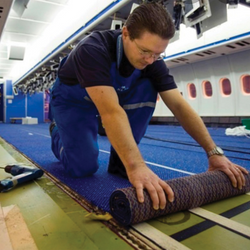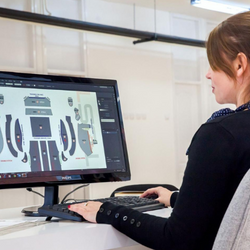The AIX team sat down with Clyde Buntrock, CEO of AJW Aviation to discuss how the landscape for maintenance, repair and overhaul (MRO) is changing in the aircraft cabin interiors industry.
Maintenance, repair, and overhaul (MRO) for aircraft cabin interiors refers to the process of inspecting, servicing, and repairing the various components of an aircraft’s cabin, such as seats, overhead bins, lavatories, and galleys.
This type of maintenance is often performed during scheduled downtime for aircraft, such as overnight or between flights. MRO services for cabin interiors may include:
- cleaning and disinfecting
- replacing worn or damaged components
- upgrading to new equipment
- making changes to the cabin layout
The goal of MRO for cabin interiors is to ensure that the cabin is safe, clean, and comfortable for passengers, and to minimise the need for costly repairs or replacements in the future.
“The global market for aircraft cabin interior MRO is expected to reach $10.8 billion by 2026, at a CAGR of 5.6% during the forecast period 2021-2026.”
Yahoo Finance
History of MRO
The history of Maintenance, Repair, and Overhaul (MRO) dates back to the early days of aviation, when aircraft manufacturers were also responsible for maintaining and repairing their own products. As the aviation industry grew, the need for specialised maintenance and repair services also increased.
During the 1920s and 1930s, many airlines began to establish their own maintenance facilities to keep their aircraft in good working condition. The first independent MRO companies also emerged during this time, offering services such as engine overhauls and component repair.
During World War II, the MRO industry played a critical role in maintaining and repairing military aircraft. After the war, many of these companies began to focus on commercial aircraft, as the demand for air travel increased.
“The commercial aircraft MRO segment is expected to grow at a higher rate than the military aircraft MRO segment.”
Aviation Week
In the 1950s and 1960s, the MRO industry continued to grow as more airlines were established and the fleet size of commercial aircraft increased. At this time, many airlines began to outsource more of their maintenance and repair needs to specialised MRO companies.

With the advent of new aircraft technologies such as jets and turbofans, MRO companies were required to adapt to new maintenance and repair procedures. By the 1970s, companies had begun to specialise in different areas of maintenance, such as avionics and component repair.
In recent years, however, MRO companies have been focusing on:
- digitalisation and automation
- sustainability
- new technologies
- safety
- regulatory compliance
Also, the industry is becoming more consolidated, with larger companies often acquiring smaller ones to expand their capabilities and geographic reach.
Current trends for MRO
There are several trends in that the aerospace industry is seeing for maintenance, repair, and overhaul (MRO), including:
Increased focus on digitalisation and automation:
Many MRO companies are investing in digital technologies such as data analytics, artificial intelligence, and the Internet of Things (IoT) to improve efficiency and reduce costs.

As Clyde Buntrock says:
“Aviation industry stakeholders are adapting to meet the ever-changing demands and needs within the commercial aviation sector.
The Group is implementing digital transformation systems within the supply chain by utilising innovative technologies such as blockchain, machine learning, and AI and is focused on developing predictive maintenance strategies.
They’ve built dynamic pricing models, predictive sales and procurement forecasting tools, as well as manpower forecasting. For the group, baking in unprecedented levels of efficiency is the key to satisfying customer demand to ensure the aerospace industry becomes more sustainable while remaining agile and efficient.”
Growing demand for sustainable and green MRO:
With increased awareness of the impact of aviation on the environment, MRO companies are looking for ways to reduce their carbon footprint and minimise waste (from production and systems including plane toilets). This includes investing in more sustainable aviation materials and processes, and using new technologies to improve fuel efficiency.
Mr Buntrock notes:
“Sustainability is an inevitability as the aviation industry works toward being more carbon neutral. It is a matter of finding the balance between economic growth through connectivity and reducing climate impact.
Suppliers need to work with their stakeholders to decarbonise the industry using innovative technology and digitisation to develop more efficient systems and practices within their business operations.”
Expansion of the aftermarket:
The market for aftermarket MRO services is growing as airlines look to outsource more of their maintenance needs. This includes services such as engine repair and overhaul, avionics, and component maintenance.
Clyde Buntrock, of AJW Aviation, says:
“The growth of the aircraft engine remarketing and leasing market has a significant impact on the commercial aviation MRO sector. As more engines are leased, there is increased demand for MRO services to support the leased engines.
As MRO providers boost their revenue, competition mounts within the MRO market, necessitating companies to upgrade and develop their services across the globe. Additionally, many engine lessors require MRO providers to be certified for the engines they are leasing, which can also drive up the quality of MRO services offered by companies like AJW Technique.
It is important to note that as the leasing market continues to grow, there is likely to be an increase in the number of engines needing to be overhauled or retired. This could have a significant impact on demand for used engine parts, which will have a positive impact on the MRO market.”
“The market for aftermarket MRO services is growing as airlines look to outsource more of their maintenance needs.”
Forbes
Greater focus on safety and regulatory compliance:
With increased scrutiny on safety and regulatory compliance, MRO companies are investing more in training and certification programs to ensure that they meet the highest standards.
Emergence of new technologies:
The MRO industry is also seeing the emergence of new technologies such as additive manufacturing, electric and hybrid propulsion systems, and unmanned aircraft systems which will require new maintenance and repair procedures.
AJW Technique, for example, is building a tablet application which encompasses the technician’s workflow with the goal of maximising component touch-time. They have also explored asset tracking solutions using Bluetooth, RFID and ultra-wide-band technologies for tooling and unit tracking within their facilities which facilitate traceability and asset management.
“The global market for MRO software is estimated to reach $4.5 billion by 2022.”
Globe Newswire
Consolidation:
The MRO industry is becoming more consolidated, with larger companies acquiring smaller ones to expand their capabilities and geographic reach.
How important is sustainability to aircraft cabin interior MRO?
As one of the key trends visible in the MRO sector, sustainability is becoming increasingly important to the aircraft cabin interiors and the aviation industry in general. With suppliers and manufacturers looking for ways to reduce its impact on the environment, MRO companies that promote sustainability are:
- Using more sustainable materials: Many MRO companies are looking for ways to use materials that are more environmentally friendly and have a lower carbon footprint. For example, some are using more natural fibres, such as bamboo and hemp, in seat fabrics and other cabin components.
Improving recycling and waste management practices: MRO companies are also focused on reducing waste and increasing recycling of materials used in cabin interiors. This includes developing new processes for recycling or repurposing used materials, such as seat covers and carpets.
“Sustainability is an inevitability and AJW Group is doing what it can where it can, to work toward a more carbon neutral industry. As such, AJW Interiors has introduced an innovative material ideally suited for use in cabin interiors.
We are the sole distributor of SkyLeather®, a revolutionary material that is changing the way we think about synthetic leather. It is a unique, sustainable, and eco-friendly alternative to traditional synthetic leather, which is made from petrochemicals.”
Find out more about SkyLeather® in our interview with AJW Group here
- Investing in new technologies: MRO companies are also investing in new technologies that can improve the sustainability of cabin interiors. For example, some are researching ways to use lightweight materials and improve energy efficiency in cabin lighting and heating systems.
- Compliance with regulations: MRO companies are also making sure that they comply with regulations related to the environment and sustainability.
“The numbers speak for themselves: an estimated 1.43 kilograms of cabin waste is generated by each passenger per flight, of which more than 20 percent is represented by untouched food and drinks.”
Michael Bauer, Airbus Cabin and Cargo Architect
From this, it’s clear that sustainability is becoming a key consideration for many MRO companies as they look to reduce their environmental impact as well as meet the expectations of their customers, who are increasingly looking for more environmentally friendly options.

What is the expected market growth of MRO?
Due to these accompanying factors, the MRO market for aerospace is expected to grow in the coming years. Factors driving this growth include:
- Increasing demand for air travel: As the global economy continues to recover, more people are expected to travel by air, which will drive demand for MRO services.
- Growing fleet size: As airlines continue to expand their fleet size, they will need more maintenance and repair services to keep their aircraft in good working condition.
- Ageing fleets: As the global fleet of aircraft ages, more aircraft will require maintenance and repair services, which will drive growth in the MRO market.
- Outsourcing trend: Many airlines are outsourcing more of their maintenance and repair services, which is also driving growth in the MRO market.
Clyde Buntrock comments:
“A quarterly MRO survey released late last year, indicated MRO sales were up across the industry, and are, in fact, the strongest they have been over the past year. These results are led by MRO sales and strength in Europe and Asia.
Despite labour shortages, supply chain fracture, spare part availability and lead times, and the ongoing Russia-Ukraine conflict, AJW remains positive about the strength in commercial aircraft maintenance and services. The impending economic pressures and weakening consumer confidence in the aviation sector are influencing the MRO sector, but the aviation industry is steadily growing, and we maintain a positive view on the year to come.
There are growing opportunities on the interiors side as airlines look to refresh and refurbish their cabin interiors, which have been neglected over the past few years. With the renewed interest in travel, airlines are looking to upgrade existing fleets while still recovering from financial losses due to the pandemic. They are looking closely at their bottom line and using MRO services to entice customers with fresh-looking aircraft interiors. As such remarketing and interior services are in demand.
It is also important to note that the growth rate of the MRO industry varies by region and by segments. For example, the commercial aircraft MRO segment is expected to grow at a higher rate than the military aircraft MRO segment. Also, the demand for MRO services in the Asia Pacific region is expected to be higher than other regions due to the increasing number of airlines and a growing fleet size.
“The demand for MRO services in the Asia Pacific region is expected to be higher than other regions due to growing fleet sizes.”
Mordor Intelligence
What are some concerns for the future of MRO?
Despite this, however, there are several concerns for the future of the Maintenance, Repair, and Overhaul (MRO) industry:
Skilled labour shortage:
The MRO industry relies heavily on skilled labour, and there is concern that there may not be enough qualified technicians and mechanics to meet demand in the future.
For example, Clyde Buntrock of AJW comments:
“During the pandemic, AJW Technique in Montreal came to realise that it had a workforce of ageing technicians, and that it risked losing hundreds of years of knowledge and experience as the older workforce began taking early retirement or left the industry. To harness this vast pool of knowledge and to create a space where it could be shared and learned by younger technicians, we birthed what we call an incubator crew.
This crew is an innovation team that supports all technological and business transformation changes across the MRO facility. The team plays the role of exploring and understanding all kinds of innovations in the marketplace that are sometimes applied in other industries but not necessarily yet in aerospace. The Group has been driven to make some of those technologies relevant to the aerospace industry and leverage the learnings and apply the technologies in its industry.”

Cybersecurity:
With the increasing use of digital technologies in the MRO industry, there is a growing concern about cybersecurity threats and the potential for data breaches.
Environmental regulations:
As governments around the world continue to tighten regulations on emissions and other environmental issues, MRO companies may face increased costs and challenges in meeting these requirements offset by the attractive production costs of, say, aircraft interior plastics.
“The aviation industry is responsible for about 2% of global CO2 emissions, and MRO companies are looking for ways to reduce their environmental impact.”
Aviation Benefits
Economic uncertainty:
The MRO industry is highly dependent on the state of the global economy, and economic uncertainty can make it difficult for companies to plan for the future.
Clyde Buntrock says:
“The global economy has a profound effect on the aviation industry. The strength of the US dollar, for example, has put pressure on airlines by driving up the cost of everything from fuel to components, and aircraft themselves. The knock-on effect of the strengthening dollar is that it has sent previously strong currencies such as the British pound and the Chinese yen plummeting this year. The pound has also been affected by the looming energy and economic crisis as well as ongoing geo-political uncertainty in the region.
International airlines recovering from the pandemic continue to face financial challenges as they raise revenue in local currencies but mostly pay for jet fuel, and maintenance and overhaul costs in dollars. Global companies who are making sales in dollars are in a good position, however, as their capital expenditure is paid in dollars as well. Companies receiving payment in local currency but have capital expenditure expenses in dollars are the ones who will struggle in the current economic climate.”

Supply Chain disruptions:
The current global situation has shown that the industry is highly dependent on the supply chain, disruptions in the supply chain can cause delays and disruptions in the maintenance processes.
Clyde Buntrock comments:
“The industry continues to experience challenges within the supply chain, which has led companies to reorganise themselves for the prospect of fluctuating aviation related volumes. These include sourcing challenges for products such as backing materials, fire blockers, and adhesives for cabin interiors.
These materials are in huge demand and subsequently, this is delaying the aftermarket and service delivery for all involved, from OEMs to airlines and third parties. Many forces are acting together and disrupting logistics, as such, we are making strategic decisions about a simpler and more nimble supply chain so that we can continue to offer our customers the service and efficiency they expect.”
Rising costs:
The cost of materials and labour are expected to continue to rise in the future, which could put pressure on MRO companies to increase prices and make it more difficult for them to compete.
Mr Buntrock adds:
“As the travel industry sees an upturn in bookings, businesses are steadily recovering after the pandemic and bringing an increase in revenue. Capital costs have also soared, which is placing pressure on all in the industry. The strong dollar has pushed up the price of new aircraft and raw materials and rising inflation rates and exchange rates are not helping the already struggling industry.
Airlines now need to deal with balancing flying schedules and pricing amidst already reduced passenger confidence in the aviation industry.”
“The MRO industry is becoming increasingly competitive as more companies enter the market, which could lead to pricing pressure and reduce profit margins.”
Contingent
Competition:
The MRO industry is becoming increasingly competitive as more companies enter the market, which could lead to pricing pressure and reduce profit margins.
As Clyde Buntrock says:
“Industry stakeholders need to be reactive, adaptable, and flexible to meet the changing needs of operators going forward. If they do not work with the changing environment of the industry, they will be left behind.”
New Technologies:
MRO companies will need to adapt to new technologies such as electric and hybrid propulsion systems, unmanned aircraft and aircraft cabin systems and new maintenance and repair procedures to keep up with the future of aviation.
As these new technologies become applicable to aerospace MRO, many of the potential challenges mentioned, like efficiency and labour costs, may well be alleviated. As such, with both growing airfleet sizes and ageing fleets, it’s not surprising that this is just one area of aircraft cabin interiors manufacturing and supply that is expected to see growth in the coming years.
FAQs
What is MRO and what services does it include?
MRO stands for Maintenance, Repair, and Overhaul and it refers to the process of inspecting, servicing, and repairing aircraft, engines, and other aviation equipment. MRO services can include scheduled maintenance, repairs, overhauls, upgrades, and modifications.
Why is MRO important for airlines?
MRO is important for airlines because it helps to ensure that their aircraft are safe, reliable, and in good working condition. Regular maintenance and repairs can help to prevent breakdowns and prolong the life of the aircraft. This can help airlines to save costs and avoid unexpected downtime.
How is MRO different from OEM?
OEM stands for Original Equipment Manufacturer and refers to the companies that produce and manufacture aircraft and their components. MRO, on the other hand, refers to the companies that provide maintenance, repair, and overhaul services for these aircraft and components.
What are some of the challenges facing the MRO industry?
Some of the challenges facing the MRO industry include the shortage of skilled labour, cybersecurity threats, environmental regulations, economic uncertainty, and supply chain disruptions.
What are some of the current trends in the MRO industry?
Some of the current trends in the MRO industry include increased focus on digitalization and automation, growing demand for sustainable and green MRO, expansion of the aftermarket, greater focus on safety and regulatory compliance, and emergence of new technologies.
How can MRO companies improve their sustainability?
MRO companies can improve their sustainability by using more sustainable materials, improving recycling and waste management practices (that consider, for example, aircraft lavatory design),, investing in new technologies, and complying with regulations related to the environment for sustainable air travel.



